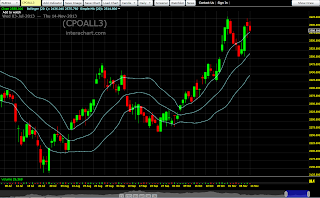The palm oil rally faces a headwind from the prospect of
slower Indian demand, Standard Chartered said, even as the vegetable oil saw
its gains overshadowed by huge headway in palm kernel oil, a knock-on effect of
the Philippines disaster.
StanChart - which in July, as palm oil prices were
approaching a three-year low, forecast a late-year revival – restated
expectations that Kuala Lumpur futures in the vegetable oil will prove higher
in the October-to-December period than in the last quarter.
But StanChart analyst Abah Ofon said that he was
"neutral" on prices at present levels, forecasting an average for the
Kuala Lumpur benchmark contract of 2,450 ringgit a tonne in the current
quarter, and of 2,575 ringgit a tonne for 2014.
Palm oil for January closed at 2,602 ringgit a tonne on
Wednesday, a gain of 0.1%, but well below the 2,627 ringgit a tonne reached in
early deals, and remaining below the one-year high of 2,632 ringgit a tonne set
on November 1.
Production ideas
Palm oil prices have been supported by concerns over output
in the major producing countries of Indonesia and Malaysia, which has failed to
show its typical scale of seasonal uptick, thanks in part to recent rains, but
also structural factors.
StanChart said that producers it had spoken too had also
flagged "the slowdown in the rate of new plantings following the global
financial crisis, a reduction in fertiliser use, and a decline in the
biological high-yield cycle following three years of strong yields".
"It now seems unlikely that Indonesia will meet its
initial production estimate of 30m-31m tonnes," Mr Ofon said, flagging
industry reports of output potentially falling below 27m tonnes.
Data for Malaysia released earlier this week surprised
investors by showing production actually rising by 60,000 tonnes month on month
in October to 1.97m tonnes, although expectations for output ahead remain below
those earlier in the year.
"Production is likely to reduce in the upcoming months,
hence trimming stockpiles," Phillip Futures said on Wednesday.
'Fading festival demand'
However, Mr Ofon highlighted the potential for a slowdown in
demand from India, the top-ranked palm oil buyer, to take some of the heat out
of the market rally.
"We expect India's crude palm oil demand to moderate in
November amid fading festival demand and expectations of a strong oilseeds
harvest," he said.
Renewed weakness in the rupee would further increased the
risk to palm oil values, in undermining the affordability of imports.
India will import 9.0m tonnes of palm oil in 2013-14, ahead
of China's 6.6m tonnes and the 5.8m tonnes bought the European Union, according
to US Department of Agriculture estimates.
Haiyan impact
Palm oil prices have gained extra support this week from
ideas that an expansion in Indonesia's biodiesel blending mandate next year
will boost demand for the vegetable oil, a major feedstock for the biofuel.
The devastation in the Philippines caused by typhoon Haiyan
has also boosted palm markets, although mainly of palm kernel oil, which is
derived from seeds and used largely in oleochemicals and making soap.
Indeed, it is an alternative to the coconut oil, of which
the Philippines is a major producer, and supplies of which are expected to be
disrupted by Haiyan damage.
"Typhoon Haiyan may disrupt the regional coconut oil
supply," Phillip Futures said.
Source: Agimoney

No comments:
Post a Comment